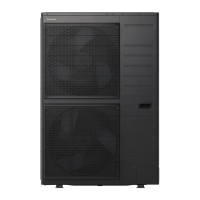
Do you have a question about the Panasonic Aquarea WH-UD16HE5 and is the answer not in the manual?
| Type | Air-to-water heat pump |
|---|---|
| Heating Capacity | 16 kW |
| Energy Efficiency Class (Heating) | A++ |
| Energy Efficiency Class (Cooling) | A+ |
| Refrigerant | R410A |
| Operating Range (Heating) | -20°C to 35°C |
Crucial safety guidelines to prevent electric shock, frostbite from refrigerants, and hazards from flammable gases.
Safety measures to prevent device damage from incorrect refrigerants, vibrations, water leaks, or fire.
Explains the fundamental working principle of air-to-water heat pumps and their components.
Highlights key product features related to energy efficiency, environmental friendliness, and user comfort.
Presents detailed technical specifications for Aquarea High Performance bi-bloc systems.
Presents detailed technical specifications for Aquarea High Performance mono-bloc systems.
Provides an overview and detailed diagrams of external interfaces for J/H and F/G generation models.
Covers determination of design outside temperature, heat load, and domestic hot water demand.
Discusses sound pressure levels, sound power, and methods for calculating sound pressure.
Provides detailed installation conditions, minimum distances, and securing methods for outdoor and indoor units.
Covers hydraulic integration, pump discharge head, pipe network resistance, balancing, and expansion vessels.
Details safety precautions and requirements for connecting the heat pump to the power supply.
Presents detailed heating and cooling capacity tables based on supply water and outside temperatures.
Essential safety guidelines for installers, covering electric shock, refrigerant handling, and device damage.
Outlines installation requirements, tools needed, and handling procedures for devices.
Covers connecting refrigerant pipes using flare fittings, with warnings about tools and torque.
Provides instructions and warnings for connecting the water heating circuit, including pipe freezing and corrosion.
Covers electrical wiring connections, safety precautions, and requirements for cable connections.
Covers system commissioning steps: refrigerant circuit evacuation, water system filling, test runs, and handover.
Detailed steps for evacuating the refrigerant circuit and performing a pressure test for bi-bloc systems.
Describes procedures for filling the hot water tank and venting the heating or cooling circuit.
Covers initial checks of the installed system, including refrigerant circuit, electrical connections, and water system.
Steps for performing a system test run, including power checks, pump speed adjustment, and water flow rate verification.
Lists essential annual maintenance checks, including water pressure, relief valve, PCBs, strainers, and RCCB.
Procedure for testing the functionality of the residual current circuit breaker (RCCB) using the TEST button.
Safety precautions and steps for performing maintenance on the refrigerant circuit, including pump-down operation.
Provides a guide to common symptoms that do not indicate malfunctions and their potential causes.
Lists error codes that may appear on the display and their corresponding explanations and causes.











